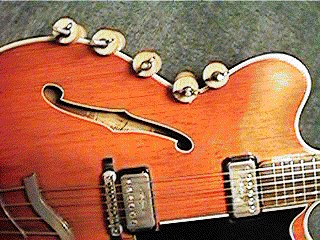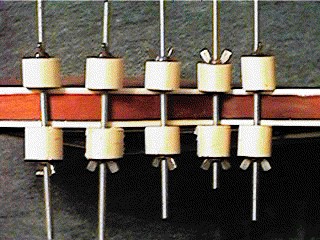1963 HOFNER VERITHIN SEMI-ACOUSTIC GUITAR
Serial No. 1395
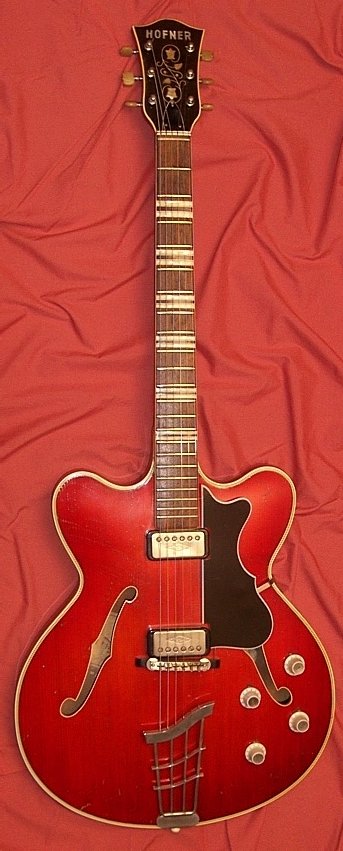
The Verithin was introduced in 1960 to the UK market, just before its European equivalent, the Model 4574, took on the rest of the world. It doesn't take much of a genius to arrive at the conclusion that this was Hofner's answer to the then extremely popular Gibson ES335, or more correctly the ES330 - the Verithin does not have the solid spruce block fitted down the centre of the body cavity as with the 335.
Verithins were produced with the Venetian double cutaways until 1965, when these were changed to pointed Florentine. Manufacture under this guise continued until 1967, although a few did appear later in dribs and drabs up to about 1971. The Model 4574, interwoven with several other variations such as the 4575 (fancy electrics),4576 (Florentine twin cutaways), and 4600 (rounded-off body edges) was produced during the period from 1961 to 1976. The European models, in true Hofner style, became numerous and complex in detail, so let's stick to the good old Selmer distributed Verithin!
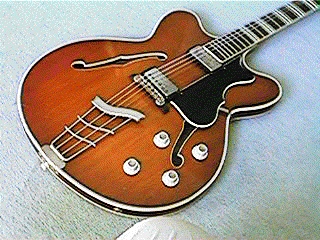
The Verithin was VERY thin; only one and a quarter inches as compared to the Gibson 330/335 body thickness of one and three guarters of an inch, and Hofner's own thinline model standard of two inches. I personally do not know of any other semi acoustic that is as slim as that! The body timbers used are in the old tradition, with laminated spruce top, and bookmatched flamed maple veneers on the back. Unusually for a mid-range Hofner, no sign of any flame is evident on the maple veneer body sides - with that thickness, I don't suppose it was really worth bothering!
With the Verithin, Hofner broke with previous convention and finished the guitar in a glorious cherry red. In the early 60s, a high proportion of Gibson 335s were finished in the same colour......guess where Hofner got the idea from! Some of the Model 4574s and the other European market derivatives were finished in a brown/red sunburst, but I have only ever seen Selmer distributed Verithins in plain cherry red.
The body edges were bound with multiple white/black plastic strips, and even the sound holes received single white binding. One up on the ES335!
The neck/body joint really did break with Hofner tradition however, with a fully inset joint into the heel and top of the body, rather than just into the heel with a cantileverd piece of the neck being suspended over the top as with all other Hofner archtops up to that time. With the minimal depth of heel that was available on the Verithin, the designers just did not have any
choice!
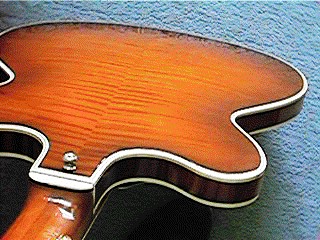
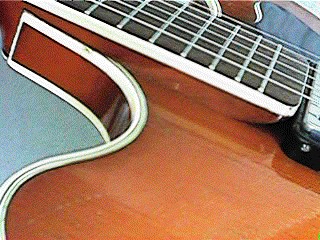
The neck is three piece maple/beech/maple, with a rosewood fingerboard. Again, a small change from the expected - I would have assumed that, to fit in with the usual Hofner pattern, a five piece neck as on the President, would have been fitted. The headstock is however pure mid-range Hofner, with its standard mother of pearl inlayed flower motif and bold Hofner maker's name. Machine heads are Hofner's usual good quality, but open geared, units.
Bold strip type fingerboard markers, of mock tortoiseshell and mother of pearl, are fitted on the Verithin, and these were no doubt chosen in order to update the rather old fashioned Hofner image. After all, this was intended to be a radical guitar, well suited for the emerging new 60s decade!
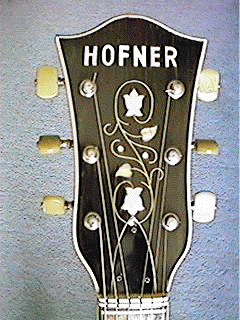
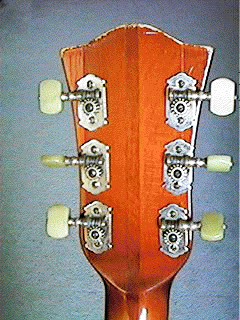
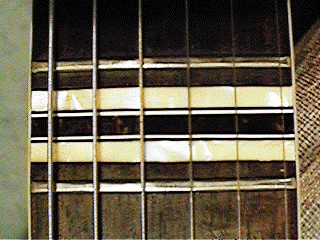
When first introduced in 1960, the Verithin was fitted with the toast rack pickups, and the classic rectangular control consul fitted with two volume controls and three sliding pickup/solo-rhythm switches. By the end of 1962 however, the electrics had been changed to as on my guitar, with the "Diamond Logo" pickups (which look like humbuckers - but aren't) and the four rotary volume and tone controls. By the end of 1963, the pickups had again changed to the humbucking "Staple" pickups, but the controls stayed the same up to the introduction of the Florentine cutaway model in 1965, when similar controls to the Ambassador were fitted, i.e. three rotary controls plus three-way selector switch. Stereo wiring was offered in the Selmer catalogue for a short time, but
guitars so fitted out are much rarer than the non-stereo versions!
All four rotary controls on my guitar interact with each other to such an extent that to define whether a particular knob controls a particulay pickup is well nigh impossible. All the sounds are there - it's just that finding any particular one is a little difficult! By the way, the guitar's acoustic sound is loud and full compared to other semis. Perhaps not having the centre block in the body helps, but the downside is that the Verithin's pickups feed-back fiercely if played at any volume near the amplifier.
Hofner's Micromatic bridge is fitted to this guitar. The ebony slotted type with the fretwire saddles, as on my Club 60, were fitted on the early Verithins (1960-63). The
"Lyre"" type tailpiece was fitted as standard throughout the whole period of Verithin manufacture, although another very artistic type (as now fitted to the present-day Hofner Jazzica) was fitted to some of the European market versions. A factory fitted Bigsby vibrato unit was offered in the UK Selmer catalogue, but a large number of European 4574s were factory fitted with a rather strange looking German copy of the Bigsby, which has four large slots stamped out of the flat chrome tailpiece to form an upper-case letter "H" (for Hofner?!) . Not half as much style though as a real Bigsby unit!
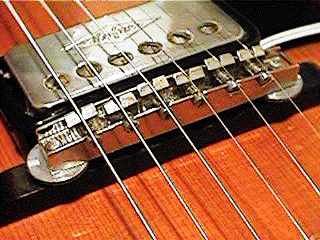
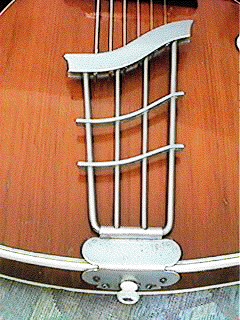
I bought this Verithin a few months
ago (1999), but amazingly it was strung with flat-wound 12s, with a wound 3rd. I am always very concerned to ensure that, in deference to the weak animal glues used on Hofners (particularly the neck joint), light
gauge strings are used for my collection. On getting the guitar home therefore, I began de-stressing the neck by relaxing the string tension over a a few days. Imagine my horror when, as the vertical pressure came off the bridge, the joint between the top of the body and the side opened up. The less tension on the strings, the wider the gap!
Unlike the Gibson thinlines, Hofner did not fit a reinforcing strip (kerfing) inside the body at the top and bottom joints of the Verithins, (although bentwood kerfing was used on most of the deeper bodied Hofners), but simply relied on the width of animal glue across the edge of the side laminates to do the business. This had obviously failed, and the only thing holding the joint together previously had been the vertical compression onto the body top from those very hefty strings. A job for an old friend of mine called John Lynch!
The following photos of the now invisible repair in progress serve to remind one that old Hofners are
vulnerable to the ravages of time, particularly on that animal glue!
